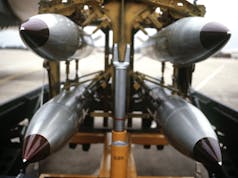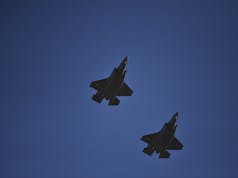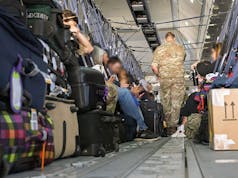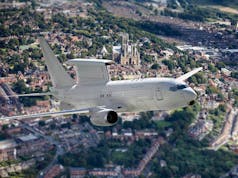The Royal Air Force (RAF) is set to trial augmented reality (AR) technology to determine its potential in increasing the number of frontline fighter pilots, according to a press release.
Under a contract with the UK Ministry of Defence, BAE Systems will conduct an in-flight demonstration of the Advanced Tactical Augmented Reality Systems (ATARS) on a Hawk TMk2 aircraft later this year.
This system, developed by US company Red 6, allows pilots to identify, engage, and defeat virtual adversaries and collaborate with synthetic wing personnel while airborne.
“Exploitation of novel technologies in an essential part of ensuring the RAF is able to sustain our combat edge and succeed on operations against a constantly evolving adversary. This latest development is a very exciting proposition and opportunity, and we are all looking forward to seeing the outcomes,” said Air Commodore Caine, Head of Flying Training and Director Flying Training, No. 22 Group RAF, quoted in the press release.
In practical terms, the pilot of a Hawk flying over the UK will see virtual aircraft through their visor, which may include another Hawk flying alongside an adversary fighter aircraft displaying hostile intent.
This synthetic training offers the opportunity to reduce the demand for live assets, drive fuel efficiencies, and achieve more training per flying hour for the trainee.
The outcome of this demonstration will help the RAF assess the interoperability and capability of this new technology as it considers whether AR should form part of its future flight training strategy. If adopted, the technology could be continuously updated to ensure pilots maintain a battle-winning edge.
“We are always looking for opportunities that innovative technologies potentially offer to improve our training delivery. Working collaboratively with industry we were able to deliver this contract at pace to allow the RAF to investigate this exciting technology to help inform future decisions around fighter pilots training,” said Commodore Jose, UKMFTS Head, in the press release.
To date, BAE Systems and Red 6 have carried out 3D scanning and feasibility assessments on the Hawk TMk2 aircraft at RAF Valley, home of No 4 Flying Training School, which trains the UK’s next generation of world-class fighter pilots. They used this digital picture of the aircraft to understand how ATARS will be integrated into the aircraft, equipping pilots for frontline fast jets, including Typhoon and Lightning.
The National Security Strategic Investment Fund (NSSIF), the UK Government’s corporate venturing arm for dual-use advanced technologies, is supporting Red 6 with its integration into BAE Systems’ Hawk.














the future is today
Still far from the rush real flying situations give the pilot.
Is it really a good idea to look for fuel savings? There comes a point below which you aren’t going to be able to achieve “more training per flying hour”. Pilots will need to develop basic air-sense through actual flying, in the same way drivers require actual time behind a wheel to get a sense of the road, no matter how good they are at Gran Tourismo or Grand Theft Auto. I worry that this mentality of save fuel/costs will lead to too few hours even before pilots get to the Hawk stage. Maybe adding extra solo flying hours early on in training using something cheap to operate, would allow for more ingrained common sense to be developed before moving on to the specialist track simulators.
This is whilst you are flying overlying as if you have other crafts either in your side or out in the distance. Not sure if it will overlay synthetic alerts saying you have a radar. Contact and simulate missile launches from adversaries etc but that would be cool. I thought the jaw has some rudimentary simulation for launch your own missiles etc already. So would save I guess fuel as you say but noting simulates as you say another person in jet coming your way acting as hostile forces with cunning and guile to try to outwit you. Still has a place if they can make it work.
” … not(h)ing simulates as you say another person in jet coming your way acting as hostile forces with cunning and guile to try to outwit you”
Depending on ground to air comms bandwidth and latency it might be possible to get part way there. Since the in-flight headset will be capable of simulating another jet outside the pilot’s cockpit perhaps at some point in the future, as the technology develops, one training scenario could be to connect the in-flight augmented-reality system to an on-the-ground virtual reality system where an instructor could fly the virtual plane. Yes, for the pilot he/she would still be missing the extra emotional/visceral impact of the real jeopardy that comes with sharing airspace with a real chunk of fast-manoeuvring heavy metal but at least such a pairing with a real life instructor on the ground controlling the virtual aircraft in real time could inject much of the “cunning and guile” of a genuine human trying to outwit you while only using fuel and airframe hours for one aircraft rather than two.
This technology is going to progress significantly over the next 10 years, just look at how stunningly realistic some of the latest video games are. We’re just at the beginning of what this technology will enable and this is quite an ambitious step along the way and maybe what I am speculating about might even be on the roadmap already.
I didn’t read the article carefully enough. It’s very interesting and I hope it facilitates the fast jet training path.
I think the sentence
“This synthetic training offers the opportunity to reduce the demand for live assets, drive fuel efficiencies, and achieve more training per flying hour for the trainee.”
misled me. Perhaps the augmented reality includes other planes and that’s where the fuel savings occur, although I still don’t get how it would achieve more training per flying hour. Less stuff to arrange between scenarios?
AR, not VR. Pilots will still be flying but engaging virtual enemies instead of other aircraft.
fusion of the virtual and the real. seems like a very good idea, certainly worth testing
To be honest, I would have thought that this training method, has been around for years. back in 1978, I was at RAF Waddington. There was a flight simulator there. The terrain was in a gigantic (well it seemed to me at the time) room, with as big a model map I had ever seen.
I cannot remember the scale, but it made the simulator realistic.
I got the wrong end of the stick on this too. It’s not a flight simulator of a Hawk; it’s a simulator while in flight on a Hawk.